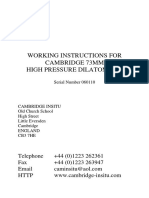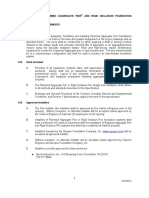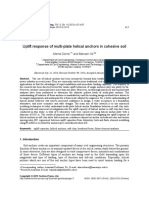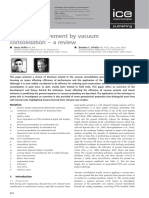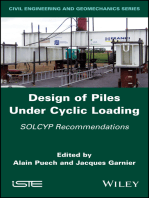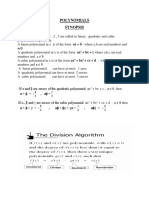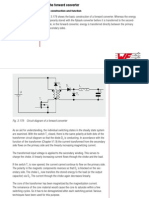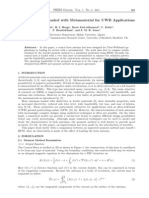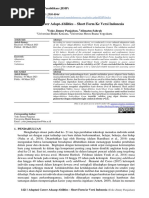Comparison of Foundation Design Specifications For Vibratory Machines
Comparison of Foundation Design Specifications For Vibratory Machines
Uploaded by
José Antonio Alarcón LeónCopyright:
Available Formats
Comparison of Foundation Design Specifications For Vibratory Machines
Comparison of Foundation Design Specifications For Vibratory Machines
Uploaded by
José Antonio Alarcón LeónOriginal Title
Copyright
Available Formats
Share this document
Did you find this document useful?
Is this content inappropriate?
Copyright:
Available Formats
Comparison of Foundation Design Specifications For Vibratory Machines
Comparison of Foundation Design Specifications For Vibratory Machines
Uploaded by
José Antonio Alarcón LeónCopyright:
Available Formats
Comparison of Foundation Design Specifications for
Vibratory Machines
William L. Bounds, M.ASCE1; and Silky S. K. Wong, M.ASCE2
Downloaded from ascelibrary.org by UNIV OF CONNECTICUT LIBRARIES on 06/22/16. Copyright ASCE. For personal use only; all rights reserved.
Abstract: Criteria for designing foundations for vibrating equipment come from published standards, recommended practices, inter-
nal company standards, and manufacturer requirements. The criteria from one source to another can vary significantly by including
or omitting specific design recommendations or by providing different values for prescribed limitations. A comparison of amplitude
criteria and several discussions of different practices and approaches can be found in ACI 351.3R, Foundations for Dynamic
Equipment. With an update of the American Concrete Institute (ACI) report in progress, this paper provides updated comparative
data between selected currently published and company specifications. Criterion topics include when a dynamic analysis is required,
machine vibration limits, human vibration limits, resonant frequency range, geotechnical impedance calculation methods, and foun-
dation sizing criteria. In addition, the background and merits of specific criteria are discussed in the paper to provide some insights
on the development of criteria. The information herein provides a frame of reference for what design criteria are considered industry
standard. Permissible amplitude figures are provided for users to compare with their proposed project specifications. Several recom-
mendations for the development of project specifications are included. DOI: 10.1061/(ASCE)SC.1943-5576.0000284. © 2016
American Society of Civil Engineers.
Author keywords: Machine foundations; Dynamic analysis; Soil impedance; Specifications; Structural design criteria; Vibration;
Frequency; Amplitude; Block foundation; Tabletop structure.
Introduction 2. Permissible vibration response for machine performance: The
response, in terms of peak displacement, velocity, or accelera-
The need to design foundations for vibrating machinery is common tion (in the vertical or horizontal direction), is based on ensur-
in industrial applications. Vibrating machinery in the petrochemical ing the planned maintenance intervals for the machine. Often,
industry typically consists of large centrifugal (rotating) or recipro- the applicable measurement location on the machine is also
cating pumps and compressors. For consistent design, most projects specified. Frequent or unplanned shutdowns resulting from
invoke specific design criteria for these foundations that are based machine failures can cause production to be halted, with result-
on supplier requirements, internal company specifications, pub- ing costly consequences. Two widely used generic charts
lished specifications, and general reference documents. In addition, include the Blake chart [Fig. 1(a)] for rotating machinery and
a number of companies have developed design practices to promote the Baxter and Bernhart chart [Fig. 1(b)] for general machine
efficient and consistent design procedures. With a number of com- vibration severity. Additional criteria can be found in BS ISO
pany (engineering contractors or owner companies) specifications 10816 (British Standards Institute 1995), which has seven parts
and published specifications in existence, the criteria provided can covering various types of machinery. Permissible amplitudes
vary widely. for the specifications discussed in this paper are presented in
The purpose of this paper is to present and discuss design criteria figure form against a background from the Baxter and Bernhart
from several sources to compare similarities, differences, and topics chart, with the slightly rough zone shaded.
that should be better addressed. The design criteria to be discussed 3. Permissible vibration response for human tolerance: The
consists of the following topics: response, in terms of peak displacement, velocity, or accelera-
1. When a dynamic analysis is needed: A dynamic calculation is tion, is limited to minimize the effect of vibration on the human
not required when some specified parameters are below mini- body. Applicable vibration limits are based on an assumed du-
mum thresholds. A criterion is usually based on the weight or ration of exposure. One widely used chart of generic vibration
power of the machine. responses resulting from human effects is the Reiher–Meister
chart (Fig. 2). Additional criteria can be found in Murray
1
Senior Fellow in Civil/Structural Engineering, Fluor Corporation, (1997), BS ISO 2631 (British Standards Institute 1997), and
One Fluor Daniel Dr., Sugar Land, TX 77478. E-mail: william.bounds@ ANSI S2.71 (American National Standards Institute 2012).
fluor.com 4. Frequency range to be avoided: Natural frequencies of the sup-
2
Structural Engineer, Fluor Corporation, One Fluor Daniel Dr., porting structure are restricted to avoid alignment with machine
Sugar Land, TX 77478 (corresponding author). E-mail: silky.wong@ frequencies (resonant conditions). Resonant conditions are
fluor.com where the response is at its maximum. In addition, the results
Note. This manuscript was submitted on September 4, 2015; approved
of a response calculation in the resonant range can be less cer-
on December 16, 2015; published online on February 29, 2016.
Discussion period open until July 29, 2016; separate discussions must be tain because of the approximate nature of most commonly used
submitted for individual papers. This paper is part of the Practice calculation methods (Fig. 3 presents a comparison). A criterion
Periodical on Structural Design and Construction, © ASCE, ISSN 1084- is commonly expressed as the ratio of machine speed to natural
0680. frequency.
© ASCE 04016009-1 Pract. Period. Struct. Des. Constr.
Pract. Period. Struct. Des. Constr., 04016009
Downloaded from ascelibrary.org by UNIV OF CONNECTICUT LIBRARIES on 06/22/16. Copyright ASCE. For personal use only; all rights reserved.
Fig. 1. Machine vibration charts (reprinted from ACI 351.3R-94, with permission): (a) Blake chart; (b) Baxter and Bernhart chart (Note: 1 mil = 1
thousandth of an inch)
5. Geotechnical impedance limitations: Many company specifica- Soil contact pressure or pile load limits are often provided to
tions and practices limit the magnitude of damping that can be avoid a nonlinear response resulting from higher strain effects (Fig.
used in a design calculation. This is because many general- 4). This criterion appears to be judgmental, and the stated criteria
purpose calculation methods tend to overestimate damping can vary widely from one specification to another.
with respect to field-measured values. Limits are described as The design criterion topics are described further for each document
either a fixed maximum damping ratio or as a fraction of the according to the following categories: general references, published
computed damping value. specifications, company standards, and manufacturer's criteria.
6. Foundation sizing: Criteria such as the mass ratio (ratio of
machine and foundation mass to machine mass), ratio of eleva-
tion machine to foundation width, and ratio of machine length General References
to mat length are often included. These are basically rules of
thumb to arrive at a first approximation prior to a dynamic anal- General references consist of published papers and textbooks that dis-
ysis. Some company specifications indicate that this type of cri- cuss general principles and guidelines. These documents are not writ-
terion as mandatory. ten in specification-type mandatory language. Some references pro-
The ratio of foundation mat width to thickness is commonly pro- vide alternative calculation procedures. Occasionally, one of these
vided to verify mat rigidity. This is because most soil or pile imped- documents is invoked through a mandatory statement in a specification.
ance calculation methods are based on the simplified assumption of Design of Structures and Foundations for Vibrating Machines
a rigid mat. (Arya et al. 1979) is a widely used book that provides
© ASCE 04016009-2 Pract. Period. Struct. Des. Constr.
Pract. Period. Struct. Des. Constr., 04016009
Downloaded from ascelibrary.org by UNIV OF CONNECTICUT LIBRARIES on 06/22/16. Copyright ASCE. For personal use only; all rights reserved.
Fig. 1. (Continued.)
procedures and equations for the design of rigid block and flex- are legally adopted in the countries where they were written.
ible tabletop-type foundations. Criteria for trial sizing are pro- A number of machine type–specific specifications are also
vided in Chapter 5. available.
Dynamics of Bases and Foundations (Barkan 1962) is the basis
for several published design specifications. The book provides pro- API RP 686: Recommended Practice for Machinery
cedures and equations for the design of soil- or pile-supported foun- Installation and Installation Design (API 2009)
dations. The described procedure is considered to be empirical, and
pile impedance procedures do not incorporate interaction effects. This recommended practice covers a wide range of aspects related
Foundation Engineering Handbook (Fang 1991), Chapter 15, to soil-supported reciprocating and rotating machines, and applies
provides the general concepts behind dynamic design for founda- if invoked in another specification. Chapter 4 covers foundation
tions and applied geotechnical engineering for the practicing engi- requirements. Specific statements are mostly in mandatory lan-
neer. Emphasis is on the determination of soil impedance. guage; however, most provisions are generically stated. For exam-
Foundations for Dynamic Equipment [ACI 351.3R (ACI 2004)] ple, Section 4.2 states that “Machinery that requires an elevated in-
provides discussions on the general concepts behind dynamic analy- stallation may be supported on structural steel of adequate strength
sis and design procedures. As of the time of publication of this paper, and stiffness.”
an update to this report is currently under review. Fig. 3.11 from the 1. When needed—A dynamic analysis is required for reciprocat-
report (Fig. 5) provides a comparison of permissible amplitudes ing machines greater than 200 hp (150 kW) and for all special-
from several sources, including four company practices. The inten- purpose equipment supported on tabletop structures.
tion of the figure is to show how permissible amplitudes can vary. 2. Machine vibration limit—Criterion is not provided.
The report update of Fig. 3.11 provided the motivation for this paper. 3. Human vibration limit—Criterion is not provided.
4. Resonant range—The natural frequency to be avoided is 0.8–
1.2 times the machine speed. If this criterion cannot be met, the
Published Specifications recommended practice states that the purchaser and vendor
should agree upon an acceptable vibration amplitude.
Several published specifications are described in this section. 5. Geotechnical impedance—No specific method or damping
The descriptions provided are summary level, because of the in- adjustments are provided.
herent complexity of the provisions, with a concentration on 6. Foundation sizing—Soil-bearing pressure is not to exceed 75%
reciprocating and rotating machines. Some of these specifications of the allowable value. Lateral eccentricity, between center of
© ASCE 04016009-3 Pract. Period. Struct. Des. Constr.
Pract. Period. Struct. Des. Constr., 04016009
Downloaded from ascelibrary.org by UNIV OF CONNECTICUT LIBRARIES on 06/22/16. Copyright ASCE. For personal use only; all rights reserved.
Fig. 2. Reiher–Meister chart (reprinted from ACI 351.3R-94, with permission) (Note: 1 mil = 1 thousandth of an inch)
mass and center of soil resistance, is not to exceed 5% for block
foundations. The mass ratio is not to exceed 3 for rotating
machines and 5–10 for reciprocating machines. The stated cri-
terion is to be applied unless a dynamic analysis or other means
is used to prove that the foundation will perform adequately.
PIP STC01015: Structural Design Criteria (PIP 2007)
This specification provides criteria for all types of process plant
designs and applies if invoked in another specification. Section
4.3.8 covers reciprocating and centrifugal machines, invokes API
RP 686, and provides additional criteria.
1. When needed—A dynamic analysis is required for reciprocat-
ing machines greater than 200 hp (150 kW) from API RP 686,
and centrifugal machines greater than 500 hp (375 kW).
2. Machine vibration limit—The limit is stated as a velocity of 3.8
mm/s (0.15 in./s) for reciprocating machines and 3.0 mm/s
(0.12 in./s) for centrifugal machines, as shown in Fig. 6.
3. Human vibration limit—Criterion is not provided.
4. Resonant range—The natural frequency to be avoided is 0.8–
1.2 times the machine speed.
5. Geotechnical impedance—No specific method or damping
adjustments are provided.
Fig. 3. Theoretical versus measured response (data from Puri 1988)
6. Foundation sizing—Soil-bearing or pile load is limited to half
(Note: 1 mil = 1 thousandth of an inch)
the allowable value.
© ASCE 04016009-4 Pract. Period. Struct. Des. Constr.
Pract. Period. Struct. Des. Constr., 04016009
Downloaded from ascelibrary.org by UNIV OF CONNECTICUT LIBRARIES on 06/22/16. Copyright ASCE. For personal use only; all rights reserved.
Fig. 4. Nonlinear effect on single pile response resulting from loading (reprinted from El-Marsafawi 1992, © ASCE)
Fig. 5. Permissible amplitude comparison (reprinted from ACI 351.3R-94, with permission) (Note: 1 mil = 1 thousandth of an inch)
CP 2012-1: Code of Practice for Foundations for factor is to be applied. The safety factor is generally consid-
Machinery (British Standards Institute 1974) ered to be 1.5.
The British specification is described as Part 1 covering reciprocat- 3. Human vibration limit—Criterion is provided as indicated by
ing machines. There is no Part 2 for centrifugal machines. the people line in Fig. 7. In addition, a safety factor is to be
1. When needed—Criterion is not provided. applied. The safety factor is generally considered to be 1.5.
2. Machine vibration limit—Criterion is provided as indicated 4. Resonant range—For important installations, the range is 0.5–
by the machine/buildings line in Fig. 7. In addition, a safety 2.0. For lesser important installations, the limit is 0.6–1.5 times
© ASCE 04016009-5 Pract. Period. Struct. Des. Constr.
Pract. Period. Struct. Des. Constr., 04016009
the machine speed. The specification does not define or elabo-
rate on important versus lesser installations. When vibration
mountings are used, the forcing frequency is to be at least 3
times the natural frequency.
5. Geotechnical impedance—Considerable content is provided on
geotechnical investigations. An appendix provides a nonman-
datory impedance procedure and example for soil-supported
foundations. The appendix procedure is based on Barkan
(1962) and omits consideration of damping, although the speci-
fication states that there may be situations where damping
could be taken into account.
Downloaded from ascelibrary.org by UNIV OF CONNECTICUT LIBRARIES on 06/22/16. Copyright ASCE. For personal use only; all rights reserved.
6. Foundation sizing—Empirical rules are provided for initial siz-
ing. The rules cover minimum foundation mass, center of mass
with respect to center of soil contact area, and foundation mat
width.
DIN 4024: Machine Foundations (German Institute for
Standardization 1988, 1991)
This German specification is composed of two parts. Part 1 covers
flexible structures for rotary machines. Part 2 covers rigid founda-
tions subjected to periodic vibrations and would include rotating
and reciprocating machines.
Both parts provide criteria for a simplified dynamic analysis that
may not be necessary or efficient when using most of the currently
available dynamic analysis software. In addition, the specification
states that a forced response analysis is not required if the founda-
Fig. 6. PIP machine response limits (Note: recip = reciprocal; 1 mil = tion is outside the specified resonant range. For a forced response
1 thousandth of an inch) analysis, Part 2 describes an equivalent static analysis method.
1. When needed—Both Part 1 and Part 2 state that a dynamic (fre-
quency or forced response) analysis is not necessary if the mass
of the rotating element is less than one hundredth of the mass of
the machine and foundation. For flexible support structures,
only directly loaded elements should be included in the founda-
tion mass. Part 2 states that a dynamic analysis is not necessary
if the highest excitation force (moment) is less than one thou-
sandth of the machine and foundation mass (mass moment of
inertia).
2. Machine vibration limit—Part 1 describes a dynamic analysis
with vibration amplitude limits based on the manufacturer's
criteria. If the manufacturer's criteria are not provided, the
specification refers to limiting values obtained from a separate
specification [VDI 2056 (Verlag des Vereins Deutscher
Ingenieure 1964)] on machine balance quality. Part 2 describes
the calculation of equivalent static loads, which are then com-
bined with the static loads. For this analysis, the specification
does not provide acceptance criteria.
3. Human vibration limit—Criterion is not provided.
4. Resonant range—Part 1 states 0.8–1.25 times the machine
speed for the first mode and 0.9–1.1 times the machine speed
for higher modes. Part 2 states a resonant range of 0.8–1.25
times the machine speed.
5. Geotechnical impedance—Part 1 states that soil impedance is
not required for analysis of flexible structures. Part 2 states that
the supporting ground shall be considered and provides an
equation for damping, but does not include specific stiffness
criteria.
6. Foundation sizing—Criterion is not provided.
Fig. 7. CP 2012-1 machine response limits (Note: 1 mil = 1 thousandth
of an inch) SP 26.13330.2012: Foundations for Machines with
Dynamic Loads (Gosstroy 2012)
This specification is a recent update adopted by the Russian
Republic. It is adapted from a previous version adopted by the
© ASCE 04016009-6 Pract. Period. Struct. Des. Constr.
Pract. Period. Struct. Des. Constr., 04016009
former Soviet Union. SP 26.13330.2012 (Gosstroy 2012) covers a 1. When needed—Criterion is provided for compressors based on
variety of dynamic machine types, including reciprocating, rotating, power (80–500 kW, or 107–671 hp), depending on the specific
forging hammer, mould casting, drop hammer table, crushers, type of machine.
machine tools, and rotary kilns. Criteria for foundations on perma- 2. Machine vibration limit—Criterion is provided for each type of
frost are included. machine as shown in Fig. 9. For rotating machine limits, there
1. When needed—Criterion is not provided. appears to be a gap between 1,000 and 3,000 rpm, with only
2. Machine vibration limit—A table of limiting values is pro- two spot values provided at 1,500 and 3,000 rpm.
vided. For rotating machines, separate limits are provided for 3. Human vibration limit—Criterion is not included.
horizontal and vertical displacements. Values are not stated for 4. Resonant range—Criterion is not provided.
frequencies above 1,500 rpm. For reciprocating machines, sep- 5. Geotechnical impedance—Prescriptive frequency-independent
arate limits are provided for primary and secondary loads. The procedures are provided for the determination of soil and pile
Downloaded from ascelibrary.org by UNIV OF CONNECTICUT LIBRARIES on 06/22/16. Copyright ASCE. For personal use only; all rights reserved.
last value applies to 600 rpm and above. With fixed amplitude impedance. The procedures are based on Barkan (1962). Pile
values for higher-speed reciprocating machines, the stated val- interaction effects are not included.
ues should be used with caution. Fig. 8 illustrates machine 6. Foundation sizing—Provisions are provided for foundation
response limits for rotating and reciprocating machines. bolt dimensioning. Foundation eccentricity limit is stated as
3. Human vibration limit—Criterion is not provided. 3–5%, depending on the ground's resistance. A number of sit-
4. Resonant range—Criterion is not provided. uation-specific recommendations are also provided.
5. Geotechnical impedance—Prescriptive frequency-independent
procedures are provided for the determination of soil and pile
impedance. The procedures are based on Barkan (1962). Pile IS 2974: Indian Standard Code of Practice for Design and
interaction effects are not included. Construction of Machine Foundations (Bureau of Indian
6. Foundation sizing—A soil pressure limit is provided based on Standards 1979, 1980, 1982, 1987, 1992)
the ground's resistance and several condition factors. The foun- This Indian specification is adopted in India and consists of five
dation eccentricity limit is stated as 3–5%, depending on the parts covering various machine types, including reciprocating,
ground's resistance. A number of situation-specific recommen- rotating, and impact.
dations are also provided. 1. When needed—Criterion is not provided.
2. Machine vibration limit—For reciprocating machines, dis-
GB 50040: Code of Design of Dynamic Machine placement limits are the same as those found in CP 2012-1,
Foundations (State Bureau of Technology Supervision except that safety factors are not described. For rotary
and Ministry of Construction 1996) machines, the criterion is provided only up to 1,500 rpm. Fig.
10 illustrates machine response limits for rotating and recipro-
This specification is adopted in China and covers a variety of
dynamic machine types, including reciprocating, rotating, crushers, cating machines, as well as human vibration limit.
mill foundations, and forging presses.
Fig. 9. Chinese Code GB 50040 (State Bureau of Technology
Fig. 8. SP machine response limits (Note: recip = reciprocal; 1 mil = 1 Supervision and Ministry of Construction 1996) machine response lim-
thousandth of an inch) its (Note: recip = reciprocal; 1 mil = 1 thousandth of an inch)
© ASCE 04016009-7 Pract. Period. Struct. Des. Constr.
Pract. Period. Struct. Des. Constr., 04016009
3. Human vibration limit—Criterion is the same as that found in
CP 2012-1, except that safety factors are not described.
4. Resonant range—Criterion is provided based on the type of
machine. For reciprocating machines, the range is 0.4–1.5
times the machine speed. For higher-speed rotating machines,
the range is 0.8–1.2 times the machine speed; however, a 50%
separation is preferred. For lower-speed rotating machines, a
20% separation is preferred.
5. Geotechnical impedance—For soil-supported foundations, spe-
cific criteria are not provided. For pile-supported foundations,
in situ tests are preferred.
Downloaded from ascelibrary.org by UNIV OF CONNECTICUT LIBRARIES on 06/22/16. Copyright ASCE. For personal use only; all rights reserved.
6. Foundation sizing—For rotating machines, soil pressure shall
not exceed 80% of the static permissible value.
Company Standards
A number of internal company written standards are in use and con-
sist of project specifications and general-use specifications. The
authors examined the general-use specifications from five compa-
nies and provided the commentary in this section.
Two companies use PIP STC01015. The remaining three com-
panies (designated as Companies A, B, and C) are discussed in the
following. The content of these specifications varies considerably,
and the language varies between mandatory and nonmandatory.
Amplitudes are often provided in terms of peak-to-peak values.
Fig. 10. IS 2974 (Bureau of Indian Standards 1979, 1980, 1982, 1987, 1. When needed—Companies A and B do not state any require-
1992) machine response limits (Note: recip = reciprocal; 1 mil = 1 thou- ments. Company C requires a dynamic analysis for vibratory
sandth of an inch) machines weighing more than 22.2 kN (5,000 lb).
2. Machine vibration limit—Limits from Companies A, B, and C
are illustrated in Fig. 11. Companies A and B have relatively
conservative limits for low-speed reciprocating machines.
Company A has a relatively conservative limit for low-speed
rotary machines.
3. Human vibration limit—Companies A and B do not include
any requirements. Company C specified that the velocity vector
sum must not exceed 2–4 mm/s (0.08–0.16 in./s).
4. Resonant range—Company A states a minimal resonant range
of 0.8–1.2 times the machine speed; however, rotating equip-
ment has additional requirements. Company B states a range of
0.7–1.3 times the machine speed for analysis cases up to 2
degrees of freedom (presumably a manual calculation) and 0.8
–1.2 times the machine speed for cases with more than 2
degrees of freedom (presumably a computer analysis).
Company C states a range of 0.5–1.5 times the machine speed.
5. Geotechnical impedance—All three companies describe
requirements for a geotechnical investigation. Company A
does not discuss any approved impedance calculation methods.
For soil-supported foundations, Company B states the use of an
“elastic half space model” theory. For pile-supported founda-
tions, Company B states that pile interaction and dynamic
effects must be considered, and the method used is subject to
owner approval. Company C provides soil spring constant val-
ues in case a geotechnical study is not available, and does not
discuss any approved impedance calculation methods.
6. Foundation sizing—All three companies include extensive
trial-sizing criteria.
Fig. 11. Company vibration limits (Note: recip = reciprocal; 1 mil = 1 Manufacturer’s Criteria
thousandth of an inch)
The manufacturer's criteria are usually provided in the form of notes
on submittal drawings. Such criteria always supersede any project-
issued specification. The importance of adhering to the manufacturer
© ASCE 04016009-8 Pract. Period. Struct. Des. Constr.
Pract. Period. Struct. Des. Constr., 04016009
For the preparation of project specifications, authors should con-
sider the following:
• State the limits below which a dynamic analysis is not
required.
• Avoid listing a textbook as a mandatory reference. Such docu-
ments are never written in mandatory language.
• Consider basing criteria on current published sources, not just
on previous practice or outdated references. For example, the
Process Industry Practices (PIP) specification is designed to be
invoked as a project specification with additional modifica-
tions to the original specification as needed.
Downloaded from ascelibrary.org by UNIV OF CONNECTICUT LIBRARIES on 06/22/16. Copyright ASCE. For personal use only; all rights reserved.
• Methods for soil/pile impedance calculations should be cov-
ered. A statement in the project-specific document to the effect
that the procedure to be used should be recognized and will
need to have the owner's approval could be provided.
Additionally, several preapproved methods could also be listed
to avoid unnecessary client approvals for widely used and rec-
ognized procedures.
• Foundation-sizing criteria should be clearly stated if it is man-
datory or preliminary to a dynamic analysis.
References
ACI (American Concrete Institute). (2004). “Foundations for dynamic
equipment.” ACI 351.3R-94, Farmington Hills, MI.
ANSI (American National Standards Institute). (2012). “Guide to the evalu-
ation of human exposure to vibration in buildings.” ANSI S2.71-1983,
Fig. 12. Manufacturer amplitude limits (Note: 1 mil = 1 thousandth of Washington, DC.
an inch) API (American Petroleum Institute). (2009). “Recommended practice for
machinery installation and installation design.” API RP 686, 2nd Ed.,
Washington, DC.
Arya, S. C., Pincus, G., and O'Neill, M. W. (1979). Design of structures and
criterion results from the strong desire not to invalidate the machine's foundations for vibrating machines, Gulf Publishing Company, Houston.
warranty. Barkan, D. D. (1962). Dynamics of bases and foundations, McGraw-Hill,
Topics often cover the machine–foundation interface, resonant New York.
frequency ratio, permissible amplitudes, and anchor bolt layout and British Standards Institute. (1974). “Code of practice for foundations for
tensioning. Responsibility for the design of the foundation remains machinery, Part 1: Foundations for reciprocating machines.” CP
with the purchaser's engineer. Permissible amplitudes for several 2012-1, London.
British Standards Institute. (1995). “Mechanical vibration—Evaluation
selected centrifugal machines are indicated in Fig. 12.
of machine vibration by measurements on non-rotating parts—
Part 1: General guidelines.” BS ISO 10816-1, Amendment 1,
Conclusions London.
British Standards Institute. (1997). “Mechanical vibration and shock—
Evaluation of human exposure to whole-body vibration, Part 1: General
Specifications invoked for usage on a project provide design criteria requirements.” BS ISO 2631-1, 2nd Ed., London.
to be used in the absence of similar provisions from the machine Bureau of Indian Standards. (1979). “Code of practice for design and
manufacturer. Based on the specification data gathered, the follow- construction of machine foundations, foundation for rotary type
ing observations and conclusions can be drawn: machines of low frequency.” IS 2974 (Part 4) (reaffirmed 2000),
• A number of company specifications and practices tend to reuse New Delhi, India.
amplitude limits determined many years ago. The original Bureau of Indian Standards. (1980). “Code of practice for design and
source of the limits is frequently no longer understood. Thus, construction of machine foundations, foundation for impact type
machines (hammer foundations).” IS 2974 (Part 2), New Delhi,
the figures in this paper are presented to provide clarity to the
India.
readers through comparisons with current industry sources. Bureau of Indian Standards. (1982). “Code of practice for design and con-
• Several of the published specifications originated in a language
struction of machine foundations.” IS 2974 (Part 1), Foundation for
other than English. The English-language versions were used reciprocating type machines, New Delhi, India.
in this paper. When reviewing these specifications, one should Bureau of Indian Standards. (1987). “Code of practice for design and con-
be careful with the precise wording because of potential trans- struction of machine foundations, foundation for impact machines
lation issues. If a provision appears to be questionable, the other than hammer (forging and stamping press, pig breaker, drop
original native-language version should be consulted. crusher, and jolter).” IS 2974 (Part 5), New Delhi, India.
• Specifications may not provide all relevant criteria. Topics of- Bureau of Indian Standards. (1992). “Code of practice for design and
construction of machine foundations, foundation for rotary type
ten not covered include human vibration tolerance, anchor bolt
machines (medium and high frequency).” IS 2974 (Part 3), New
materials and tensioning, grouting materials and installation Delhi, India.
requirements, and impedance calculation methods. The design El-Marsafawi, H., Han, Y. C., and Novak, M. (1992). “Dynamic experi-
engineer will need to apply judgment and experience to pro- ments on two pile groups.” J. Geotech. Eng., 10.1061/(ASCE)0733
vide a complete design. -9410(1992)118:4(576), 576–592.
© ASCE 04016009-9 Pract. Period. Struct. Des. Constr.
Pract. Period. Struct. Des. Constr., 04016009
Fang, H.-Y. (1991). Foundation engineering handbook, Van Nostrand PIP (Process Industry Practices) (2007). “Structural design criteria.” PIP
Reinhold, New York. STC01015, Austin, TX.
German Institute for Standardization. (1988). “Machine foundations, Puri, V. K. (1988). “Observed and predicted natural frequency of
flexible structures that support machines with rotating elements.” DIN a pile foundation.” Proc., 2nd Int. Conf. on Case Histo-
4024-1, Berlin. ries in Geotechnical Engineering, Univ. of Missouri-Rolla, St.
German Institute for Standardization. (1991). “Machine foundations, rigid struc- Louis.
tures for machinery subject to periodic vibration.” DIN 4024-2, Berlin. State Bureau of Technology Supervision and Ministry of Construction.
Gosstroy. (2012). “Foundations of dynamic load machines.” SP (1996). “Code of design of dynamic machine foundations.” GB 50040,
26.13330.2012, Moscow. Bejing.
Murray, T. M., Allen, D. E., and Ungar, E. E. (1997). “Steel design guide se- Verlag des Vereins Deutscher Ingenieure. (1964). “Standard of evaluating
ries 11, floor vibrations due to human activity.” American Institute of the mechanical vibration of machines.” VDI 2056., Duesseldorf,
Steel Construction, Chicago. Germany.
Downloaded from ascelibrary.org by UNIV OF CONNECTICUT LIBRARIES on 06/22/16. Copyright ASCE. For personal use only; all rights reserved.
© ASCE 04016009-10 Pract. Period. Struct. Des. Constr.
Pract. Period. Struct. Des. Constr., 04016009
You might also like
- Tensile Membrane Structures 2016Document63 pagesTensile Membrane Structures 2016José Antonio Alarcón León100% (2)
- Ug190554 - Foundation Design ReportDocument33 pagesUg190554 - Foundation Design ReportHeril JainNo ratings yet
- Cambridge 73mm High Pressure Dilatometer - Working InstructionsDocument113 pagesCambridge 73mm High Pressure Dilatometer - Working InstructionsAnonymous Re62LKaACNo ratings yet
- Aggregate Pier and Rigid Inclusion Specification 9-22-2014Document9 pagesAggregate Pier and Rigid Inclusion Specification 9-22-2014Sen HuNo ratings yet
- A2 PDFDocument16 pagesA2 PDFMirza SakibNo ratings yet
- Elastic Settlement Shallow Foundations - A Critical Review 2 PDFDocument35 pagesElastic Settlement Shallow Foundations - A Critical Review 2 PDFmohdpat05100% (2)
- The Bird of Happiness Dominoes Two PDFDocument65 pagesThe Bird of Happiness Dominoes Two PDFJosé Antonio Alarcón LeónNo ratings yet
- Spe 137748 PaDocument13 pagesSpe 137748 PaIbrahim ElsawyNo ratings yet
- Theoretical and Exper Study Steel PropsDocument7 pagesTheoretical and Exper Study Steel PropsAnonymous ePcnZoBENo ratings yet
- 1999 Bruno-Randolph-1999-dynamic-and-static-load-testing-of-model-piles-driven-into-dense-sandDocument11 pages1999 Bruno-Randolph-1999-dynamic-and-static-load-testing-of-model-piles-driven-into-dense-sandlbiNo ratings yet
- D 2936 - 95 Rdi5mzytotu - PDFDocument2 pagesD 2936 - 95 Rdi5mzytotu - PDFLupita CarelyNo ratings yet
- Aashto Agc ArtbaDocument50 pagesAashto Agc ArtbasaeedNo ratings yet
- Site Specific Ground Response Analysis PDFDocument9 pagesSite Specific Ground Response Analysis PDFSudan ShresthaNo ratings yet
- 1 RMR PDFDocument14 pages1 RMR PDFchakrapanithotaNo ratings yet
- Post-Liquefaction Volumetric Strain of Gravel-Sand Mixtures in Constant Volume Simple ShearDocument12 pagesPost-Liquefaction Volumetric Strain of Gravel-Sand Mixtures in Constant Volume Simple ShearJiaer Wu0% (1)
- Prefabricated Vertical Drains: L.D College of Engineering AhmedabadDocument24 pagesPrefabricated Vertical Drains: L.D College of Engineering AhmedabadSparsh ShukalNo ratings yet
- Lees Ali 2023 Surfacebcapstronggranlayeronweakersand ICEDocument11 pagesLees Ali 2023 Surfacebcapstronggranlayeronweakersand ICEOum MahmdNo ratings yet
- Calibration of PET Strap Pullout Models Using A Statistical ApproachDocument15 pagesCalibration of PET Strap Pullout Models Using A Statistical ApproachApoorva AgarwalNo ratings yet
- t81 061 PDFDocument12 pagest81 061 PDFArun KumarNo ratings yet
- Manual PDADocument366 pagesManual PDAAndy SugiantoNo ratings yet
- 2013 Asem13 Geotubes FemDocument11 pages2013 Asem13 Geotubes FemJose Leo MissionNo ratings yet
- The Behaviour of Embankments On Clay FoundationsDocument1 pageThe Behaviour of Embankments On Clay FoundationspicottNo ratings yet
- PreviewpdfDocument90 pagesPreviewpdfSheeraz AhmedNo ratings yet
- An Introduction To Pressuremeters PDFDocument28 pagesAn Introduction To Pressuremeters PDFAnonymous Re62LKaACNo ratings yet
- Behaviour of Laterally Loaded Piles in Layered Soil DepositsDocument4 pagesBehaviour of Laterally Loaded Piles in Layered Soil DepositsSudharsananPRSNo ratings yet
- FYP-Final Presentation-Group 17 (Final Version)Document46 pagesFYP-Final Presentation-Group 17 (Final Version)Hizb UllahNo ratings yet
- Public Version of HPC PCSR3 Sub-Chapter 3.2 - Classification of Structures, Systems, Safety Features and ComponentsDocument87 pagesPublic Version of HPC PCSR3 Sub-Chapter 3.2 - Classification of Structures, Systems, Safety Features and ComponentsEm GerNo ratings yet
- Opss - Prov 932: Ontario Provincial Standard SpecificationDocument10 pagesOpss - Prov 932: Ontario Provincial Standard SpecificationRaymondLeungNo ratings yet
- Clay Reinforcement Using Geogrid Embedded in Thin Layers of Sand PDFDocument12 pagesClay Reinforcement Using Geogrid Embedded in Thin Layers of Sand PDFThãshñêëShävNo ratings yet
- D6026-21 Standard Practice For Using Significant Digits and Data Records in Geotechnical DataDocument6 pagesD6026-21 Standard Practice For Using Significant Digits and Data Records in Geotechnical Dataangeles vegaNo ratings yet
- 01 Geocell Mattress For Heavy Duty Working Platform Over Soft Soil - Geotec...Document5 pages01 Geocell Mattress For Heavy Duty Working Platform Over Soft Soil - Geotec...alexandru_brani8053No ratings yet
- Pywall v3 Validation NotesDocument17 pagesPywall v3 Validation NotesXuejian LiuNo ratings yet
- Ufc 3 220 01aDocument196 pagesUfc 3 220 01aKin JazzNo ratings yet
- Drilled Shaft Lateral Load Test ClayDocument110 pagesDrilled Shaft Lateral Load Test ClaychrtromNo ratings yet
- Bolton - 1999 - A Non-Linear Elasticperfectly Plastic Analysis For Plane Strain Undrained Expansion TestsDocument9 pagesBolton - 1999 - A Non-Linear Elasticperfectly Plastic Analysis For Plane Strain Undrained Expansion TestsHUGINo ratings yet
- Data Report Downhole Seismic Field14Document9 pagesData Report Downhole Seismic Field14Thanh NguyenNo ratings yet
- Cross-Wind Vibrations of Steel ChimneysA New Case HistoryDocument10 pagesCross-Wind Vibrations of Steel ChimneysA New Case HistoryLibo Yan100% (1)
- Is 2720 5 1985 PDFDocument20 pagesIs 2720 5 1985 PDFsagarNo ratings yet
- Artigo - Numerical Studies of Anchored Sheet Pile Wall Behavior Constructed in Cut and Fill CoDocument9 pagesArtigo - Numerical Studies of Anchored Sheet Pile Wall Behavior Constructed in Cut and Fill CoMikhael GouveiaNo ratings yet
- Wind Engineering Research Needs 2011 07Document4 pagesWind Engineering Research Needs 2011 07Khắc Tự NhậtNo ratings yet
- Assessment of Mass Modulus of A WeatheredDocument4 pagesAssessment of Mass Modulus of A WeatheredBrian ConnerNo ratings yet
- Full-Scale Pullout Tests and Analyses of Ground Anchors in Rocks Under Ultimate Load Conditions PDFDocument10 pagesFull-Scale Pullout Tests and Analyses of Ground Anchors in Rocks Under Ultimate Load Conditions PDFLuiz Felipe Goulart FiscinaNo ratings yet
- Paper 5 - Tara PDFDocument10 pagesPaper 5 - Tara PDFAltaf Hossain100% (1)
- Static Cone Tests and Settlement of Calcareous Desert SandsDocument7 pagesStatic Cone Tests and Settlement of Calcareous Desert SandsATHIRA K RAJANNo ratings yet
- Laboratory Modeling of Laterally Loaded Pile GroupDocument12 pagesLaboratory Modeling of Laterally Loaded Pile GroupMUHAMMAD ILHAM DIRGANTARANo ratings yet
- Faroukhi - Monogram On Thermal CoductivityDocument151 pagesFaroukhi - Monogram On Thermal CoductivitynitingkulkarniNo ratings yet
- A Necessary Change in The Seismic Design Provisions of The 2000 IbcDocument10 pagesA Necessary Change in The Seismic Design Provisions of The 2000 IbcZeeshanNo ratings yet
- Non Vibro Stone Columns-Thysenkrupp-19.10.2021Document22 pagesNon Vibro Stone Columns-Thysenkrupp-19.10.2021Deepak avinashNo ratings yet
- 1-Principles and Practice of Ground Improvement-Wiley (2015) - 3Document1 page1-Principles and Practice of Ground Improvement-Wiley (2015) - 3Ahmed KhedrNo ratings yet
- Cancelled: Unified Facilities Criteria (Ufc)Document196 pagesCancelled: Unified Facilities Criteria (Ufc)khawarNo ratings yet
- 2014 - Ground Improvement by Vacuum Consolidation - A Review - ICE Ground ImprovementDocument17 pages2014 - Ground Improvement by Vacuum Consolidation - A Review - ICE Ground ImprovementG-SamNo ratings yet
- The Direct Shear Strength and Dilatancyof Sand-Gravel MixturesDocument27 pagesThe Direct Shear Strength and Dilatancyof Sand-Gravel MixturesPipatpong NookhaoNo ratings yet
- Performance Based Analysis of Seismic Capacity of Mid Rise BuildingDocument9 pagesPerformance Based Analysis of Seismic Capacity of Mid Rise BuildingJahid Jahidul Islam KhanNo ratings yet
- Valores Límites de DesplazamientosDocument7 pagesValores Límites de DesplazamientosDaniel PatiñoNo ratings yet
- Ground Improvement Using Stone ColumnDocument7 pagesGround Improvement Using Stone ColumnPallavi VermaNo ratings yet
- Aspects of Across-Wind Loads and Effects On Large Reinforced Concrete ChimneysDocument179 pagesAspects of Across-Wind Loads and Effects On Large Reinforced Concrete ChimneysAnonymous hprsT3WlPNo ratings yet
- The Effects of Patch Loads On Thin-Walled Steel Silos: M. Gillie, J.M. RotterDocument18 pagesThe Effects of Patch Loads On Thin-Walled Steel Silos: M. Gillie, J.M. RotterAnonymous wWOWz9UnWNo ratings yet
- MUK-GEN - 700 - 000 - 0001-C2-Specification For Piling and Embedded Retaining WallDocument47 pagesMUK-GEN - 700 - 000 - 0001-C2-Specification For Piling and Embedded Retaining WalloscarNo ratings yet
- Eq Linear Stiffness and Damping in Rocking of Circular and Strip FoundationsDocument25 pagesEq Linear Stiffness and Damping in Rocking of Circular and Strip FoundationseiudkNo ratings yet
- Design of Piles Under Cyclic Loading: SOLCYP RecommendationsFrom EverandDesign of Piles Under Cyclic Loading: SOLCYP RecommendationsAlain PuechNo ratings yet
- A Catalogue of Details on Pre-Contract Schedules: Surgical Eye Centre of Excellence - KathFrom EverandA Catalogue of Details on Pre-Contract Schedules: Surgical Eye Centre of Excellence - KathNo ratings yet
- An Introduction to Thermogeology: Ground Source Heating and CoolingFrom EverandAn Introduction to Thermogeology: Ground Source Heating and CoolingNo ratings yet
- IADC/SPE 87100 New Method of Representing Rock Properties Over Entire Bit Run Improves Computer Generated Bit RecommendationsDocument9 pagesIADC/SPE 87100 New Method of Representing Rock Properties Over Entire Bit Run Improves Computer Generated Bit RecommendationspendexxNo ratings yet
- Kaveh A., Colliding Bodies Optimization Extensions and Applications, 2015Document291 pagesKaveh A., Colliding Bodies Optimization Extensions and Applications, 2015José Antonio Alarcón LeónNo ratings yet
- FIB 16 Design Examples For The 1996 FIP Recommendations Practical Design of Structural ConcreteDocument193 pagesFIB 16 Design Examples For The 1996 FIP Recommendations Practical Design of Structural ConcreteJosé Antonio Alarcón LeónNo ratings yet
- Development of Analytical Model For Thrust Restraint Design - Part 2: Segmented PipelinesDocument16 pagesDevelopment of Analytical Model For Thrust Restraint Design - Part 2: Segmented PipelinesJosé Antonio Alarcón LeónNo ratings yet
- StEERLagunasPeruMay262019EarthquakeP-VASTReport Final PDFDocument106 pagesStEERLagunasPeruMay262019EarthquakeP-VASTReport Final PDFJosé Antonio Alarcón LeónNo ratings yet
- FEM MATLAB Code For Geometric Nonlinear Analysis of Membranes PDFDocument12 pagesFEM MATLAB Code For Geometric Nonlinear Analysis of Membranes PDFJosé Antonio Alarcón LeónNo ratings yet
- Fed0 PDFDocument73 pagesFed0 PDFJosé Antonio Alarcón LeónNo ratings yet
- 4 Seminar-Mosalam-Minho-Oct-1-2012-RedDocument117 pages4 Seminar-Mosalam-Minho-Oct-1-2012-RedJosé Antonio Alarcón LeónNo ratings yet
- AISC-Efficient Analysis For Steel Design PDFDocument352 pagesAISC-Efficient Analysis For Steel Design PDFJosé Antonio Alarcón LeónNo ratings yet
- Engineering Structures: Ashraf El Damatty, Amal ElawadyDocument14 pagesEngineering Structures: Ashraf El Damatty, Amal ElawadyJosé Antonio Alarcón LeónNo ratings yet
- Tower Foundation Design PDFDocument90 pagesTower Foundation Design PDFboontharaksaNo ratings yet
- Advance Steel 2018 Implementation GuideDocument156 pagesAdvance Steel 2018 Implementation GuideJosé Antonio Alarcón LeónNo ratings yet
- A96967-9 Attachment 3.1 Geotech RPT HDD Qew Pages 1-46 - A6Q4Z7Document46 pagesA96967-9 Attachment 3.1 Geotech RPT HDD Qew Pages 1-46 - A6Q4Z7Jenny FuyuanNo ratings yet
- For Service Training 4jh1 TC Engine EngiDocument79 pagesFor Service Training 4jh1 TC Engine EngiMark LoretoNo ratings yet
- Factors Affecting Contractors' Performance in Construction Project Delivery in Akure, Ondo State, NigeriaDocument23 pagesFactors Affecting Contractors' Performance in Construction Project Delivery in Akure, Ondo State, NigeriaMuhammad IqbalNo ratings yet
- 1.1 Detailed Workload MatrixDocument2 pages1.1 Detailed Workload MatrixFaZe MoHANo ratings yet
- FC & ICC2 CMNDSDocument34 pagesFC & ICC2 CMNDSshagufta.mujeebNo ratings yet
- Predicative Complexes With The InfinitiveDocument3 pagesPredicative Complexes With The InfinitiveКарина КупрашNo ratings yet
- Class X Maths StudentSupportMaterial-2020-21Document155 pagesClass X Maths StudentSupportMaterial-2020-21laxmaxNo ratings yet
- Surface Tension Measurement of Normal Human Blood Samples by Pendant Drop MethodDocument12 pagesSurface Tension Measurement of Normal Human Blood Samples by Pendant Drop MethodAtikah Aulia PuteriNo ratings yet
- Spesifikasi Ipal BRM-5 (Mesin)Document1 pageSpesifikasi Ipal BRM-5 (Mesin)Adi SaputraNo ratings yet
- DATABASE Section Toward The Bottom of This Document.: The Silktest Ocr ModuleDocument5 pagesDATABASE Section Toward The Bottom of This Document.: The Silktest Ocr ModulenitijNo ratings yet
- Fabrication of Removable Partial DenturesDocument49 pagesFabrication of Removable Partial DenturesAmitaNo ratings yet
- Soalan SPM Paper 1Document34 pagesSoalan SPM Paper 1Anandraj GovindarajNo ratings yet
- Fortimail VM InstallDocument21 pagesFortimail VM InstallWassim El MririeNo ratings yet
- Polynomials Synopsis: + BX + C Where A, B, C Are Real + BX + CX + D, Where A, B, C Are RealDocument9 pagesPolynomials Synopsis: + BX + C Where A, B, C Are Real + BX + CX + D, Where A, B, C Are RealThanveer AhmadNo ratings yet
- III Applications: 2 Step: Defining The Turns RatioDocument4 pagesIII Applications: 2 Step: Defining The Turns RatioivekusNo ratings yet
- Calculation of MPP, Afc, TVC, Avc, TC, Atc and MCDocument6 pagesCalculation of MPP, Afc, TVC, Avc, TC, Atc and MCmanish KumarNo ratings yet
- IMOC講義題目Document6 pagesIMOC講義題目zhuangshaoshao1225No ratings yet
- Vol 7 No 2 Page 161 To 165Document5 pagesVol 7 No 2 Page 161 To 165abubakarshaNo ratings yet
- HameedDocument45 pagesHameedHassan JavaidNo ratings yet
- En Schirmung LoResDocument24 pagesEn Schirmung LoResRonald Brayan Navarro OrdóñezNo ratings yet
- Rautaruukki Steels Under Critical Conditions 2005Document101 pagesRautaruukki Steels Under Critical Conditions 2005Alex DimulescuNo ratings yet
- Section A: Ques. 1Document31 pagesSection A: Ques. 1Anmol RaiNo ratings yet
- ML Ques Bank For 2nd Unit PDFDocument5 pagesML Ques Bank For 2nd Unit PDFshreyashNo ratings yet
- Differential CalculusDocument10 pagesDifferential CalculusDan Arris LaurestaNo ratings yet
- Bearing Capacity of Soil: 7.0 SyllabusDocument35 pagesBearing Capacity of Soil: 7.0 SyllabusHans Hans SadzNo ratings yet
- Panjaitan & Sarah (2023) - Adaptasi Career Adapt-Abilities - Short Form Ke Versi Indonesia PDFDocument11 pagesPanjaitan & Sarah (2023) - Adaptasi Career Adapt-Abilities - Short Form Ke Versi Indonesia PDFEliasFundiceNo ratings yet
- Montare Distributie Audi A6 C7 2.0 TdiDocument12 pagesMontare Distributie Audi A6 C7 2.0 TdiEduard ŞtefanNo ratings yet
- Prepositional Logic - Definition: Discrete Mathematics - Propositional LogicDocument6 pagesPrepositional Logic - Definition: Discrete Mathematics - Propositional LogicLarry RicoNo ratings yet
- Resume BlackedDocument1 pageResume BlackedAnonymous MvjZXf6No ratings yet


